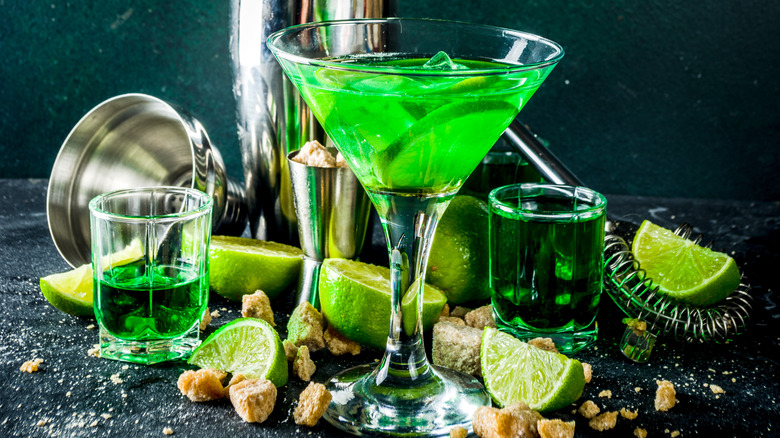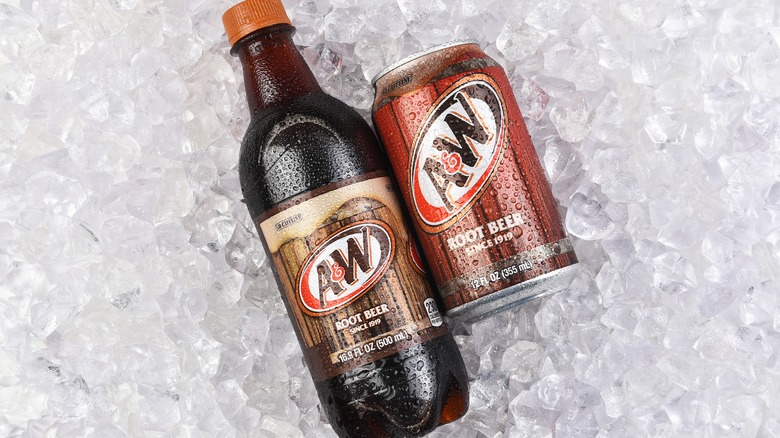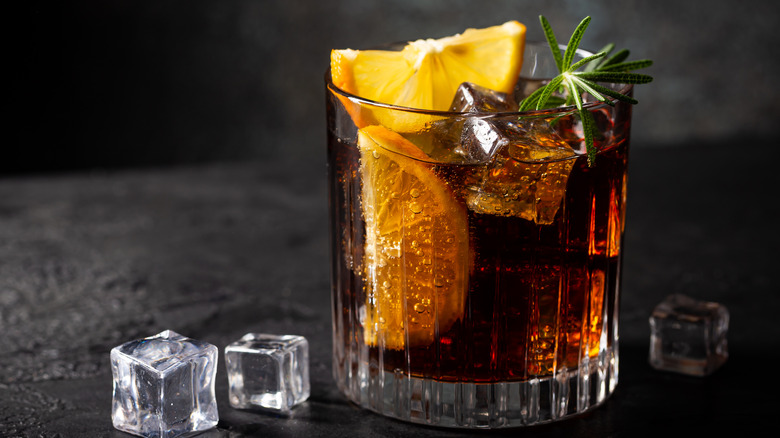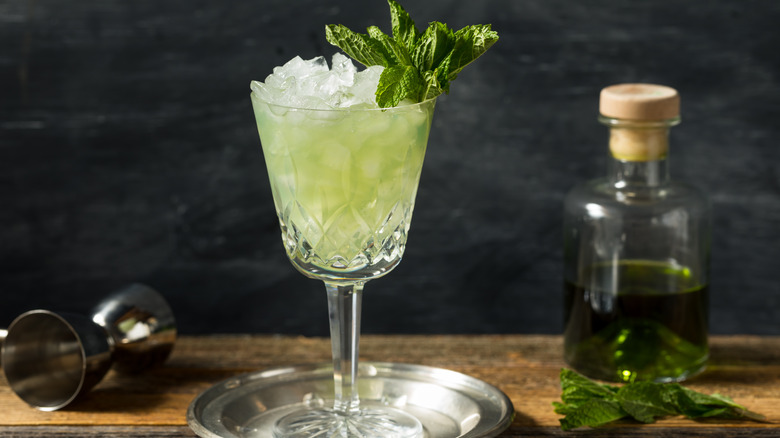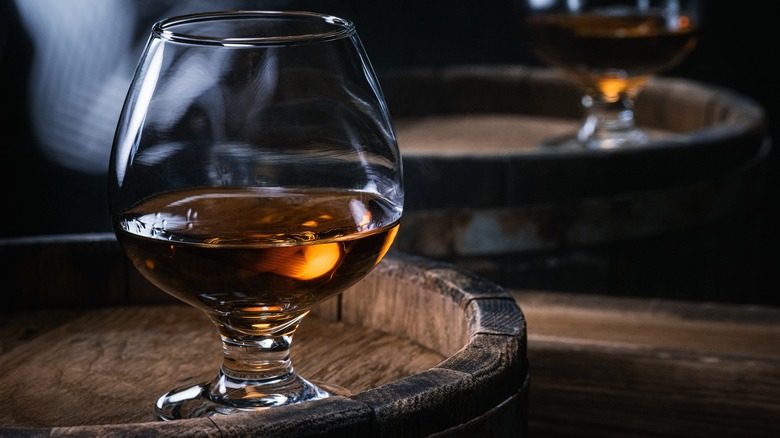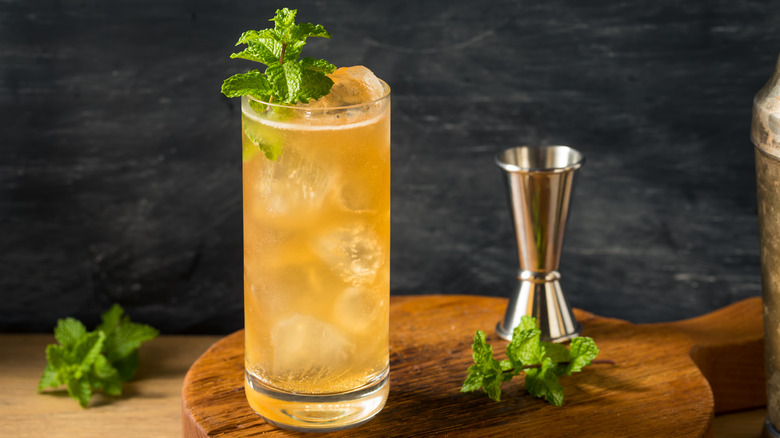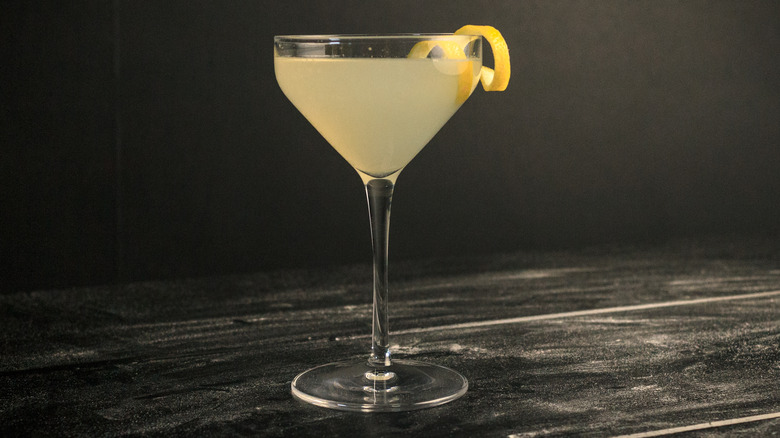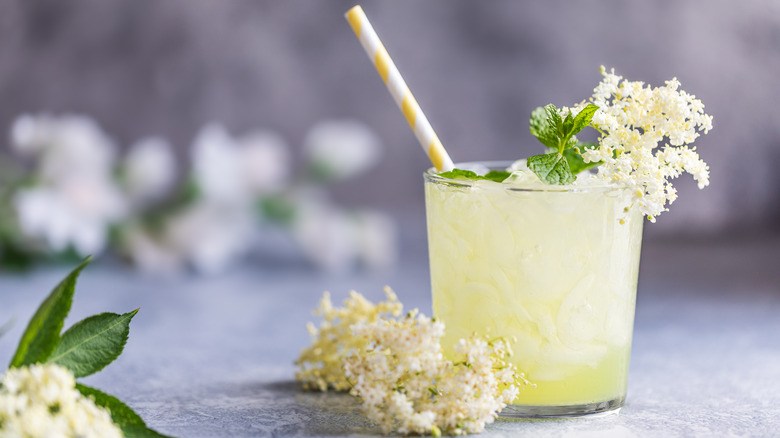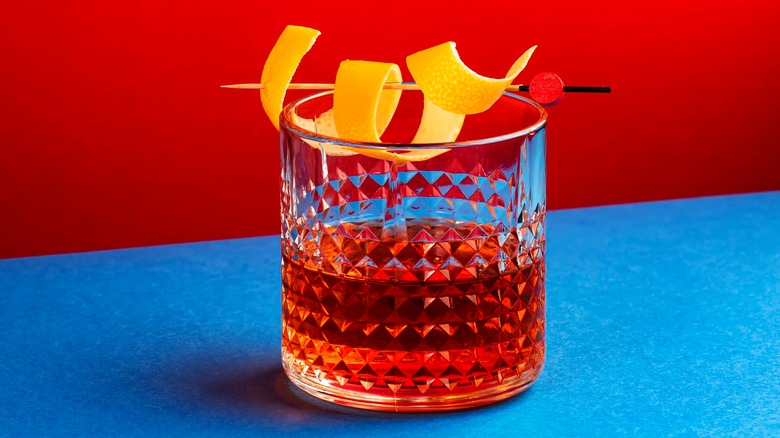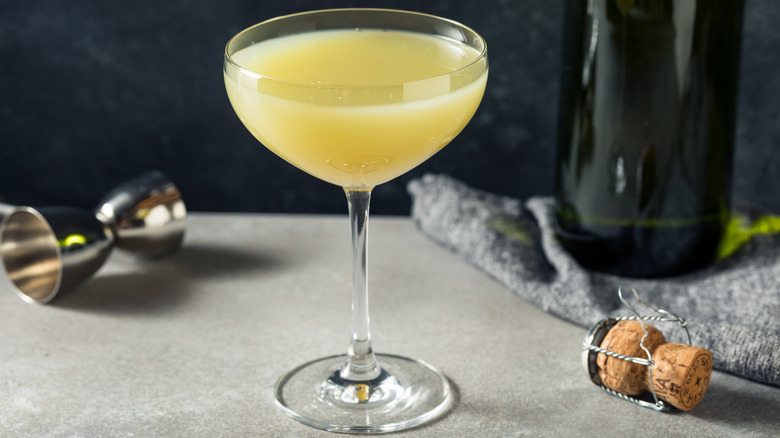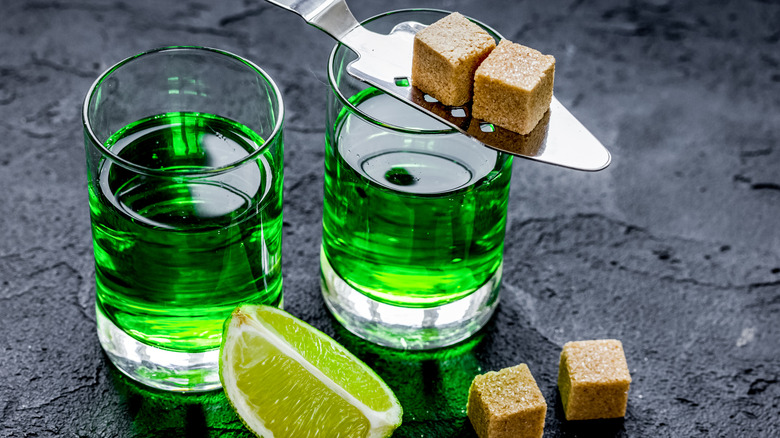10 Drinks To Mix With Absinthe For Easy Cocktails
Absinthe has quite the storied history and, to this day, it's one of the most misunderstood spirits out there. It's also one of the most "intriguing," thanks in part to the fact that it was banned in the United States until 2007. As Mic explains, absinthe first originated in Switzerland and is a grain alcohol made with a number of herbs and spices, consisting mainly of fennel and anise, which give it its signature licorice taste, and wormwood, which gives it its signature green hue.
Absinthe was all the rage in the late 1800s, especially among artists, and was wrongly believed to cause hallucinations. Later research showed most of the negative side effects attributed to absinthe were simply due to its extremely high alcohol content, which hasn't changed since its return to the spotlight. These days, depending on the brand, absinthe has between 40 and 75% alcohol, and so, should be enjoyed with caution. Whether it's your first time drinking absinthe, or you are a longtime fan, you will definitely want to turn it into a cocktail, like an absinthe margarita or a sage-absinthe concoction. Alternatively, you can keep it simple and just add a single mixer to your shot of absinthe.
Root Beer
Root beer is often overlooked when it comes to mixers, with most folks opting to reach for a traditional cola instead. However, as Liquor.com notes, that's a real shame because root beer is actually "a natural addition to spirits" and is full of "unrealized potential." Said potential includes blending its "distinctive bite" and "earthy notes," which come from the sassafras root that's used to make it, with everything from bourbon to absinthe. As the outlet points out, root beer packs its own "hint of anise" and that, in turn, compliments the same notes found in absinthe.
Punch calls the combination truly "robust" and "complex," and explains that root beer pairs well with absinthe because it's "a nonalcoholic amaro — a robust, complex drink layered with sarsaparilla and other botanicals." A mix of one part absinthe to four parts root beer is ideal, and you can even top the whole thing off with a lemon twist, if you're feeling fancy.
Rum
The unique anise flavor that's inherent to absinthe can be tricky to pair, but mix it with spiced rum and you will have yourself a drink that's both deliciously "spicy" and seriously "potent," per Food & Wine. This unlikely combination is also the perfect jumping off point for crafting island-inspired drinks that lend themselves to the ultimate armchair travel. Simply drop in some bitters with fruity notes and you've got yourself a quick and simple "tropical sipper." Alternatively, pour in pineapple juice and coconut water or syrup for a twist on the classic Piña colada: the Absinthe colada.
You can also try your hand at crafting a Dunderstruck cocktail, which uses the mix of rum and absinthe as a base that's then paired with Campari and strawberry. In that case, the absinthe does much more than just deliver a punch of flavor; it also helps to "soften the bitter edge of Campari, making the whole drink more complex and magical," per Cocktail Party.
Soda water
Whether it's your first time trying absinthe or you are a longtime fan who's searching for a mixer that's light and refreshing, you will want to reach for some soda water. This simple combination comes together to create a classic cocktail called the Absinthe Frappe. As Serious Eats explains, it was all the rage in the late 1800s and early 1900s thanks to its "cooling qualities and rich but delicate flavor" and it hasn't lost any of those attributes. Best described as "pleasant" and "refreshing," the mix of absinthe and soda water delivers a "high-proof, cool refreshment" that Moody Mixologist calls "simple, tasty, and very effective!"
Originally invented in New Orleans back in 1874, it became the go-to morning cocktail and even inspired a song called "Absinthe Frappe," which appeared in the 1904 musical "It Happened in Nordland." All you have to do is mix an ounce of absinthe with chilled soda water (to taste) and enjoy. If you find the result too bitter, you can also add a dash of sugar.
Cognac
Absinthe reached peak popularity in 19th-century France when it "became a symbol and a fuel for a caravan of creative individuals," including painters like Vincent Van Gogh and Henri de Toulouse-Lautrec. Not only did A-list artists enjoy drinking absinthe, which they often called the Green Fairy, but they also immortalized it in countless works of art. And, in the case of Toulouse-Lautrec, he even invented a timeless drink to honor his favorite liquor. Mixing his beloved absinthe with Cognac, the painter crafted what Saveur calls an "intense potion," which he then reportedly served at all of his parties.
As Spirits Hunters explains, Toulouse-Lautrec aptly called his concoction Le Tremblement de Terre, or Earthquake, because it was "notoriously potent" and "rather intense." Saveur recommends mixing 2.5 ounces of Cognac with only 0.25 ounces of absinthe for a bold blend you won't soon forget. You can also elevate the mix with some Cointreau and Suze, a "bitter and aromatic" digestif, to create a unique cocktail called La Tour Eiffel.
Ginger ale
Ginger ale is a go-to mixer for countless cocktails because, as A Couple Cooks so rightly notes, "it's bubbly, it's sweet, and it makes any cocktail taste better." What's more, its subtle yet zingy ginger taste helps bring out a variety of flavors without being overpowering. It's no wonder then that ginger ale has also become a staple when crafting highball cocktails, which rely heavily on a glassful of non-alcoholic mixer and just a single shot of liquor.
This includes the absinthe highball, which is a great way for first-time absinthe drinkers to get acquainted with its signature taste that legendary potency. Simply mix half an ounce of absinthe with four ounces of ginger ale and you'll have a refreshing drink to sip on during brunch and beyond. If you want to add a bit more kick, Difford's Guide suggests dropping in a few dashes of Angostura bitters.
Gin
You can't go wrong with a classic gin and tonic, but how about trying a gin and absinthe, as suggested by Food & Wine? As The Spruce Eats notes, they may be "two equally bold ingredients," but they "actually work wonderfully together." The unexpected pairing is especially tasty when using a "full-bodied" gin that has hints of fruits and botanicals, which will help compliment absinthe's anise flavor. Mix two parts gin to one part absinthe for a knockout blend, or get creative and add a few more ingredients to punch things up.
Drop in a dash of orange bitters and you'll have a "fascinating" and "complex" cocktail called the Dorflinger, which has been around since before Prohibition. Alternatively, pour in some lemon juice, Cointreau, and dry vermouth and you'll have a "tart and zingy" Corpse Reviver No 2, which was immortalized in print back in 1930, proving that absinthe and gin have gone hand-in-hand for decades.
Lemonade
Spiked lemonade is an essential summer thirst-quencher for cocktail lovers. Whether you prefer to use vodka, rum, or even wine, the tangy beverage pairs well with "many different types of liquor" and you can pour in whatever you have on hand, per A Couple Cooks. However, if you're feeling adventurous and want to surprise your guests (or your taste buds!), shake things up with absinthe. Mix the two ingredients in a ratio of 1 part absinthe to 4 parts lemonade and you'll arrive at a "refreshing summer sip" that's almost too easy to drink.
As Food & Wine notes, "just half an ounce of absinthe takes over" a jar of fresh lemonade, which in turn does "a great job of balancing out the anise flavor" of absinthe. The tasty result is "light, refreshing, and a great introduction for anyone a little intimidated by absinthe." You can also go one step further and turn your absinthe-lemonade blend into a unique mojito by adding fresh lime juice and mint.
Whiskey
Absinthe and whiskey — a classic combination that has withstood the test of time. It's a "simple yet potent" pairing that was reportedly invented in New Orleans way back in the 1800s and actually constitutes the base for one of the "first true cocktails" in the world: the Sazerac. As Serious Eats notes, the combination of absinthe and whiskey is not for the faint of heart, but it is a great choice for whiskey lovers. The Spruce Eats calls the unexpected addition of absinthe "a nice way to doctor up rye whiskey," as the ingredients balance each other out and absinthe "perfectly" accents whiskey.
Bar director Erik Adkins told Whisky Advocate that the pairing works so well because "bourbon, with its sweetness, its kind of caramel flavor, can take some herbal notes, which you get from the anise" notes in absinthe. New Orleans bartender Joe Tangney agreed, adding that absinthe "seems to just open up flavors" found in whiskey and "just a few dashes help to enhance the other flavors." The combination is a "powerful, brawny" mix that's "as stiff as they come," per Serious Eats, but it's a formidable pairing you will want to try at least once. Add a sugar cube and Peychaud's Bitters and you'll have the full-blown Sazerac.
Champagne
Legendary author Ernest Hemingway is best known for his literary masterpieces, but his love of drink is no secret, either. In fact, he "drank heavily" for much of his life and cocktails had a way of regularly making their way into his novels. What will likely surprise Hemingway fans, however, is that he's also credited with inventing a "strong but surprisingly refreshing" absinthe cocktail. Taking its name from his 1932 novel of the same title, Death in the Afternoon combines absinthe with sparkling, refreshing champagne. According to Liquor.com, Hemingway shared the recipe in a 1935 cocktail book called "So Red the Nose, or Breath in the Afternoon," and instructed that all you need to do is pour out "one jigger" of absinthe into a Champagne glass, then top it off with "iced Champagne until it attains the proper opalescent milkiness."
As the outlet points out, the "effervescent" result is great for first-time absinthe drinkers and, thanks to how smooth and easy it is to drink, it's the perfect addition to any brunch. A ratio of 1 part absinthe to 4 parts champagne is ideal.
Water
The most traditional way to drink absinthe is with ice-cold water, which helps dilute the drink's potent alcohol content without eliminating its signature anise flavor. You'll need patience, though. Absinthe 101 suggests the fountain method in which you'll want to place a shot glass with about an ounce of absinthe into a bigger glass, then slowly pour ice-cold water into the shooter. The absinthe will spill over and you'll continue pouring until there's nothing but water left in the shot glass. At that point, you can remove it and sip on the perfectly mixed absinthe-water left in the bigger glass.
Alternatively, there's the oldest way to enjoy absinthe, which is called the ritual for a reason. First popularized in France, per The Spruce Eats, it will require you to pour about an ounce of absinthe into a small glass, place a fork (or special absinthe spoon with holes) on top with a sugar cube, then ever-so-slowly drip three to five ounces of "ice-cold, distilled water" over it. The water will help "release" absinthe's unique "herbal bouquet," while the melted sugar will help cut through its bitterness. According to Epicurious, the ideal ratio of absinthe to water is anywhere between 1:3 and 1:6. Cheers!
